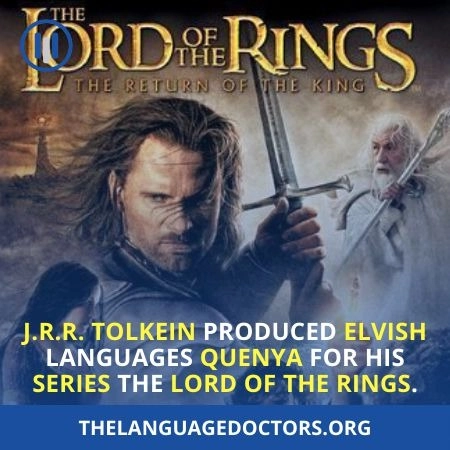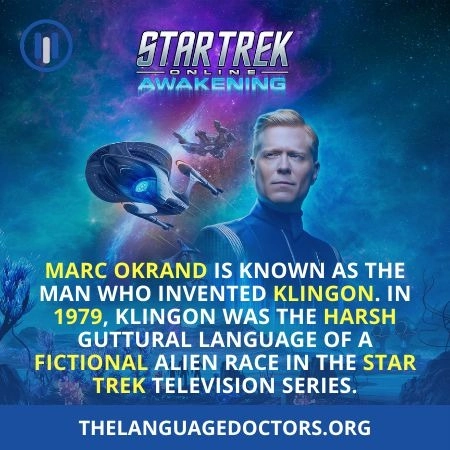What Are Fictional Languages?
Fictional languages are humans creations, but not in a natural way. Unlike natural languages, fictional languages only exist within an imaginary world. As fictional languages have a unique, alien-sounding grammar, lexicon, and phonology. Fictional languages are present in literature and movies. They support the credibility of the story world. The goal is to provide fascination, and extra depth to the world represented in the work of art. Hence the name artistic languages. Fictional languages in a film created with different goals in mind. Such as film production feasibility, audience satisfaction, and political neutrality. The number of fictional languages made for movies and TV shows is keeping increasing. They’re also known as “constructed languages.” Fictional languages are a subset of a constructed language. Constructed Languages (ConLang) Constructed languages were deliberated construct rather than having evolved. These languages are also called artificial, planned, fictional, invented, or artistic languages. It depends on the specific outline of the body of languages that a speaker or writer refers to.List Of Most Popular Fictional Languages You Can Learn:
Fictional languages have a powerful effect on film, TV, and literature. And their cultural impact has been tremendous, so much so that you can learn some fictional languages in real life. Yes! You can teach yourself fictional languages with a little effort. Let’s start with the most famous one.1. Dothraki – Game of Thrones
When it comes to creating a language, there is not a textbook method to follow. Game of Thrones is a stellar example. David J. Peterson created spoken Dothraki for Game of Thrones. It is a television adaption influenced by the descriptions of George R.R. Martin. Dothraki consist of 3163 words. However, Dothraki doesn’t sound anything like natural languages. Yet, it has few real words of Russian, Swahili, and Turkish. It is one of the most utter and convincing fictional languages ever devised.
2. Valyrian:
Besides Dothraki, Peterson also created the High Valyrian language for Season 3 of Game Of Thrones. In the sprawling series of George R.R. Martin, we have specific isolated expressions in High Valyrian. Such as ‘Valar Morghulis’ means ‘all men must die.’ Or ‘dracarys’ means ‘dragon fire.’ And also, ‘Valar Dohaeris’ means ‘all men must serve.’ David J. Peterson contributed to the Duolingo course. It is a course in High Valyrian for English speakers that began on October 31, 2016.3. Quenya – Lord of the Rings
R. R. Tolkien is known as the first person to create a complete fictional language. J.R.R. Tolkein drew inspiration from his favorite languages to develop new ones. He is the author of The Hobbit and The Lord of the Rings series. For his fantasy world, he produced two Elvish languages in detail. Quenya and Sindarin. The Quenya language first appeared in 1937. Quenya has an influence of Finnish, Latin, and Greek. The most striking resemblance between Quenya and Finnish is their agglutinative nature. Many affixes can be added to words to change their significance. Examples:
Elen síla lumenn’ omentielvo – A star shines on the hour of our meeting.
Many humans have taken to learning Quenya. Online guides and Elvish dictionaries are available to help fans picking up the language themselves.
The Quenya language first appeared in 1937. Quenya has an influence of Finnish, Latin, and Greek. The most striking resemblance between Quenya and Finnish is their agglutinative nature. Many affixes can be added to words to change their significance. Examples:
Elen síla lumenn’ omentielvo – A star shines on the hour of our meeting.
Many humans have taken to learning Quenya. Online guides and Elvish dictionaries are available to help fans picking up the language themselves.
4. Sindarin:
Indeed, Tolkien was one of the great linguists. The common tongue spoken by the Elves is Sindarin. Welsh shapes Sindarin. Almost all sounds are the same across both languages. Sindarin has spoken by the Grey Elves of Telerin. But now, it has taken a life of its own. And humans, too, directly talk to Sindarin. I ambar na- anew ‘The world is a new!’ Sauron is the main character of Lord of the Rings.5. Fictional Languages – Black Speech:
Black Speech was the official language of Mordor, where Sauron rules. Black Speech is also known as The Dark Tongue Of Mordor. Tolkien didn’t develop Black Speech into a full language. Tolkien himself found it vile. Even today, it is not wholly dead.6. Klingon – Star Trek
Klingon is the most developed constructed language. Marc Okrand is known as the man who invented Klingon. In 1979, Klingon was the harsh guttural language of a fictional alien race in the Star Trek television series. Klingon has its alphabet, with a vocabulary of around 3,000 words. An adaption of Shakespeare’s Hamlet published in Kingston. Fans use the language to write songs or for saying wedding vows.
It is one of the most studied fictional languages. According to the Klingon Language Institute, about one thousand people
from over thirty nations have learned Klingon since the publication of the dictionary in 1985.
Klingon has its alphabet, with a vocabulary of around 3,000 words. An adaption of Shakespeare’s Hamlet published in Kingston. Fans use the language to write songs or for saying wedding vows.
It is one of the most studied fictional languages. According to the Klingon Language Institute, about one thousand people
from over thirty nations have learned Klingon since the publication of the dictionary in 1985.
7. Vulcan – Star Trek
Several languages from Star Trek are frequently studied. Vulcan was the basic to be heard on the original series. And was the language of Vulcans of the planet Vulcan. The most famous phrase in the Vulcan language is the oh-so-provocative pon far, which means “time of mating.” Who knows?8. Atlantean – The Lost Empire
Marc Okrand also creates an Atlantean language for the Disney film Atlantis: The Lost Empire. The language spoken by the native race of Atlantis; it’s also the city’s mother tongue.9. Alienese – Futurama
Alienese is probably the most straightforward language on the list to learn. It is the language of the fictional alien species Nibblonian. Who are native to the Planet Eternium. The alien languages in Futurama are a set of hidden in-jokes. Alienese is coded English.10. Na’vi – Avatar
Na’vi is one of the newer fictional languages. Linguist Paul Former created it in the blockbuster film Avatar. James Cameron, the Director, also made 30 words of Na’vi, the blue-skinned humanoids’ language. It took six months to develop an extensive vocabulary we heard in the film. Today, Na’vi has a full grammatical structure and a vocabulary of around 2,000 words.11. Huttese – Star Wars
Huttese is one of the odd fictional languages in Star Wars. Ben Burtt is the creator of Huttese. And set up in the Quechua language. The fictional language spoken by the jumbo species of crime lords knows as Hutts. Star Wars universe has plenty of constructed languages for its various alien races. Ewoks is one of them.12. Lapine – Watership Down
Watership Down is the story of a rabbit society looking for a new shelter. Lapine is the constructed language of characters from Watership Down, created by Richard Adams in 1972. It has appeared in film and TV adaption. Lapine comes from the French word for rabbit. And meant to sound “fluffy.”13. Barsoomian – John Carter
Barsoomian is the constructed language of the fictional wise inhabitants of Mars. Edgar Rice Burroughs created it. First Barsoom story serialized under the Moons of Mars in 1912 and published as a novel ‘A Princess of Mars’ in 1917. Many developments on a theatrical film adaptation of the ‘Barsoom’ series emerged in the 20th century. John Carter was the leading character in this novel.14. Fictional Languages – Nadsat
Nadsat is one of the most appealing fiction languages. It has about 300 words. Teenagers speak them in a Clockwork Orange. Anthony Burgess invented it. The language is English and is affected by many Russian words and phrases.15. Newspeak:
Newspeak is one of the most significant constructed languages. George Orwell created it. He wasn’t a linguist but one of the most influential writers of the 20th century. It is a controlled language developed by the totalitarian state Oceania. Newspeak was a simpler version of English to communicate in 1984.
16. Kryptonian:
Kryptonians are a fictional cosmic nation of humanoids within DC Comics. Kryptonian is the language of the fictional Planet Krypton (birthplace of Superman). E. Nelson Bridwell invented it. It has an alphabet of 118 letters. And is read as symbols inspired by Egyptian hieroglyphics.Fictional Languages – An Overview
Search Engine Say: “There are approximately 312 constructed languages”. Including: Mangani, Minionese, Parseltongue, R’Lyehian, Slydavian, and Ulam. The origination of fictional language is still a mystery due to the lack of direct evidence. There are different hypotheses. Some suggest that language cannot have evolved out of anything. Or it must relate to other animal communication systems. While others present an opposite view, claiming that language is a uniquely human faculty. And it must have appeared in an already developed form. The first known conlang is Lingua Ignota, which means an unknown language. That was created in the 12th century by St. Hildegard of Bilgen.Fictional Languages – Purpose
There are several possible reasons to create a fictional language. Such as: – To ease human communication – To give fiction an added coat of realism – For experimenting in the field of linguistics – For artistic creations – And for language gamesFictional Languages – Conclusion:
As long as there are languages, they will keep inspiring people to create their own. J.R.R. Tolkien spent many decades fine-tuning Quenya, Sindarin, and the other languages. In his epic fantasy trilogies. But Tolkien wasn’t alone. Using believable fictional languages aid, readers believe in mythology. And imbue themselves in the world. The aim is to get used to new sounds and a unique manner of arranging words. So your fictional language doesn’t sound like another spin on English. When it comes to practical use, off international auxiliary languages, Esperanto will remain the absolute number one. With an estimate, there are 2 million Esperanto-speakers worldwide. It was introduced in 1887. And in 1954, it was accepted by UNESCO as an official language.Source: 16 Amazing Fictional Languages You Don't Know - TLD (thelanguagedoctors.org)

